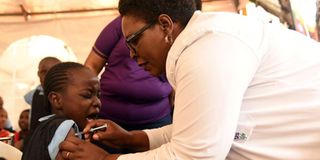Bosire: Vaccinate girls to save them from cervical cancer

A healthcare worker administers the cervical cancer vaccine to Mwajuma Jillo at Hola Referral Hospital.
What you need to know:
- Cervical cancer is the leading cause of cancer death among Kenyan women aged 15 to 44 years.
- Vaccinating efforts against HPV also improve and prolong life for adolescents and young people living with HIV.
- The vaccine targets the HPV subtypes accountable for 70 per cent of cervical cancer.
Despite the world convening for ICPD25+ in 2019 and Global leaders making commitments to safeguard the health of women and young girls, there continues to be increased opposition against reproductive rights of women; opposition that has hindered access to safe reproductive services including cervical cancer prevention interventions. As a young girl who grew up in the slums of Kibera, in an environment where quality, affordable and timely healthcare did not exist, this reality remains true for many young girls living in poor households in Kenya.
In July 2019, a video went viral in Kenya, of a young woman narrating her ordeal in not being able to access healthcare for her sister who had been diagnosed with cervical cancer. She spoke, amidst tears, of how accessing care was difficult because they did not have enough money, Sh 1,950 (less than $20 US dollars). The young woman unfortunately succumbed to death.
Proper screening and vaccination
Hers is not an isolated case. As a medical doctor, this is the reality of many women, particularly those from rural and informal settlement areas. Cervical cancer is the leading cause of cancer death among Kenyan women aged 15 to 44 years. Precisely, 3,286 out of 5,250, or 62 per cent, of women diagnosed with cervical cancer die from a disease that is preventable though proper screening and vaccination. While screening girls and women for cervical cancer can and should be scaled up to reduce the incidence of cervical cancer, the cervical cancer vaccine offers an unprecedented opportunity to protect future generations of women. It is also an equaliser of the inequities and inequalities that exist in healthcare.
Vaccination is the best investment by the government.
When it comes to cervical cancer screening, multiple factors often hinder these efforts on a large scale. For instance, the Ministry of Health rolled out cervical cancer screening efforts in 2006, but the highest recorded screening was only 16.4 per cent , 9 years later in 2015. More typically, around 14 per cent of women were screened, meaning that a full 86 per cent of Kenyan women were never screened for cervical cancer. The low rates can be attributed to a range of health systems challenges such as lack of human resources, supply chain issues with procurements of reagents and preservation of specimen, long hospital queues and weak quality assurance mechanism in our public laboratories. There were disparities in who was screened, with low screening rates among younger women from rural areas; girls that lived in poor households; girls and younger women who had a low education level; those who had challenges accessing information; as well as those with poor access to health insurance. These factors are also predictive of poor health outcomes from cervical cancer.
Vaccine completely safe
Given in two doses, in line with international guidelines by WHO, the HPV vaccine guards against future HPV infection by stimulating bodies to produce cells called anti-bodies which will fight HPV in the future. The vaccine targets the HPV subtypes accountable for 70% of cervical cancer. Vaccinating a greater population at risk offers herd immunity so that even those who have not been vaccinated can be protected. The vaccine is completely safe with the occasional temporary localised pain and soreness at site of injection. Vaccinating efforts against HPV also improve and prolong life for adolescents and young people living with HIV as cervical cancer is the most common AIDS- related cancer and the sixth most common AIDS-defining illness in women. Vaccination against cervical cancer supports our national and global goals of Universal Health Coverage by reducing the financial costs of treating cervical cancer later. It achieves equity in access to healthcare so that girls and women from poor households can access care while also ensuring that the quality of care is good enough to improve the health of those receiving.
Of course, screening remains a critical tool, particularly for women of reproductive age. When detected early, cervical cancer is highly treatable. But screening cannot be the only tool. Therefore, the combination of screening and widespread administering of the HPV vaccine will result in the greatest protection against cervical cancer. Cancer of the cervix is one of the few cancers that is 100 per cent preventable. Vaccination is the best way to save lives, and people in positions of authority should put their support behind it.
Dr Bosire is a Human rights Medical doctor, a student of law and an activist. She can be reached at [email protected]





